Vol. 18 - Num. 71
Grupo PrevInfad/PAPPS Infancia y Adolescencia
Valoración de la agudeza visual
Jaime García Aguadoa, Francisco Javier Sánchez Ruiz-Cabellob, Julia Colomer Revueltac, Olga Cortés Ricod, M.ª Jesús Esparza Olcinaa, José Galbe Sánchez-Venturae, José M.ª Mengual Gilf, M Merino Moina, Carmen Rosa Pallás Alonsoh, Ana Martínez Rubioi, Grupo PrevInfad/PAPPS Infancia y Adolescenciaj
aPediatra. Madrid. España.
bPediatra. CS Zaidín Sur. Granada. España.
cDepartamento de Pediatría, Obstetricia y Ginecología. Unidad de Pediatría. Universidad de Valencia. Valencia. España.
dPediatra. CS Canillejas. Madrid. España.
ePediatra. CS Torrero La Paz. Zaragoza. España.
fPediatra. CS Delicias Sur. Zaragoza. España.
hServicio de Neonatología. Hospital Universitario 12 de Octubre. Madrid. España.
iPediatra. CS de Camas. Sevilla. España.
jJosé María Mengual Gil (coord.).
Correspondencia: J García. Correo electrónico: jgaguados@gmail.com
Cómo citar este artículo: García Aguado J, Sánchez Ruiz-Cabello FJ, Colomer Revuelta J, Cortés Rico O, Esparza Olcina MJ, Galbe Sánchez-Ventura J, et al. Valoración de la agudeza visual. Rev Pediatr Aten Primaria. 2016;18:267-74.
Publicado en Internet: 27-07-2016 - Número de visitas: 224558
Resumen
El método preferido de cribado visual entre los tres y los cinco años es la medida directa de la agudeza visual con optotipos. En el presente trabajo se describe el procedimiento de valoración de la agudeza visual con optotipos, se analizan los requisitos que deben cumplir los optotipos más adecuados y se actualizan los criterios de derivación a oftalmología de acuerdo con las recomendaciones más recientes.
Palabras clave
● Agudeza visual ● Alteraciones visuales ● Cribado ● OptotiposINTRODUCCIÓN
El método preferido de cribado visual entre los tres y los cinco años es la medida directa de la agudeza visual con optotipos. La agudeza visual (AV) es la capacidad del sistema visual para diferenciar dos puntos próximos entre sí y separados por un ángulo determinado (α en la Fig. 1).
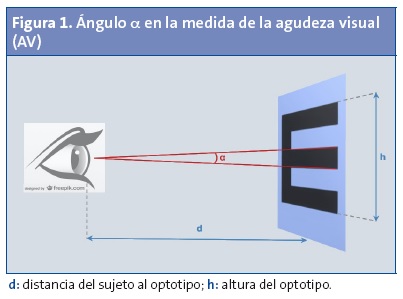
Matemáticamente, la AV en valor decimal se define como la inversa del ángulo α expresado en minutos de arco* (AV=1/α). Aunque en teoría la AV puede ser mayor de 1, en la práctica clínica se considera que la agudeza visual normal se sitúa en torno a la unidad (AV = 1), lo que significa que el ángulo α es de 1 minuto de arco.
El ángulo α se conoce como ángulo mínimo de resolución (MAR, acrónimo del inglés minimum angle of resolution) e indica el tamaño angular del detalle más pequeño que es capaz de identificar un observador en el optotipo. El MAR se calcula hallando la inversa del valor decimal de la AV (MAR = 1 / AV). Para una AV de 1, el MAR será de un minuto de arco, para 0,5 es de dos minutos y, para una AV de 0,1 el MAR será de diez minutos. Este valor es poco utilizado en la práctica, empleándose más su logaritmo decimal (LogMAR).
Aunque en general se entiende que un optotipo es el conjunto de letras, signos o figuras de diversos tamaños que se utilizan para medir la agudeza visual, en optometría el término optotipo hace referencia a cada uno de los símbolos o figuras impresos en las tablas.
TAMAÑO DE LOS OPTOTIPOS
Si suponemos que el observador está situado en el centro de una circunferencia cuyo radio es la distancia del observador al optotipo, el MAR expresado en mm es el detalle más pequeño que se puede ver y nos indicará el grosor de las letras o símbolos que debe tener un optotipo para cada rango de AV. Esta cifra depende de la distancia del observador al optotipo. Veamos dos ejemplos.
- Si el observador está situado a una distancia de cinco metros (5000 mm) del optotipo, la longitud en mm de la circunferencia será 2 × 3,1416 × 5000 = 31 416 mm. Dividiendo esta cifra por 360 primero y por 60 a continuación, obtendremos el valor del minuto de arco de la circunferencia: 31 416 / 360 × 60= 1,45 mm. Así pues, para una AV de 1, el optotipo debe tener un grosor de 1,45 mm; para una AV de 0,5 (MAR= 2 minutos de arco) el grosor del optotipo será de 1,45 × 2 = 2,9 mm, y para una AV de 0,1 (MAR = 10) el optotipo tendrá un grosor de 14,5 mm.
- Si el observador se sitúa a tres metros del optotipo, la longitud de la circunferencia será de 2 × 3,1416 × 3000 = 18 849,6 mm y un minuto de arco de la circunferencia medirá 18 849,6 / 360 × 60 = 0,87 mm. Por tanto, para una AV de 1, el grosor del optotipo será de 0,87 mm, para una AV de 0,5 será de 1,74 mm y para una AV de 0,1 el grosor será de 8,7 mm.
El tamaño total del optotipo está establecido en cinco veces el grosor de la letra o símbolo (5 minutos de arco) (Fig. 2). A una distancia de 5 m, el tamaño del optotipo será el siguiente: 7,25 mm para una AV de 1 (1,45 × 5), 14,5 mm para una AV de 0,5 (2,9 × 5) y 72,5 mm para una AV de 0,1 (14,5 × 5). A una distancia de 3 m, el tamaño será de 4,35 mm, 8,7 mm y 43,5 mm respectivamente.
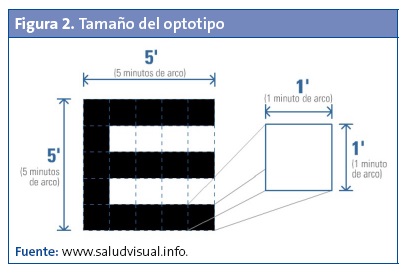
CLASES DE OPTOTIPOS
Las escalas más utilizadas son la decimal, la Snellen y la logMAR (Tabla 1). Los optotipos de Snellen fueron publicados en 1862 y en pocos años se convirtieron en el estándar para la determinación de la agudeza visual. Las deficiencias en su desarrollo dieron lugar a diversas propuestas de mejora que fueron implementadas por Bayley y Lovie al introducir en 1976 los principios de la estandarización de los optotipos1. En la actualidad se considera que los optotipos estandarizados según los criterios de Bayley y Lovie son superiores y su uso está recomendado por diversos organismos como la Organización Mundial de la Salud2, el International Council of Ophthalmology3 o el Royal College of Ophthalmologists4. Tienen la ventaja de que miden la agudeza visual con mayor precisión y fiabilidad y se han impuesto en el ámbito de la investigación, aunque en la práctica clínica habitual sigue siendo muy frecuente el uso de los optotipos de Snellen.
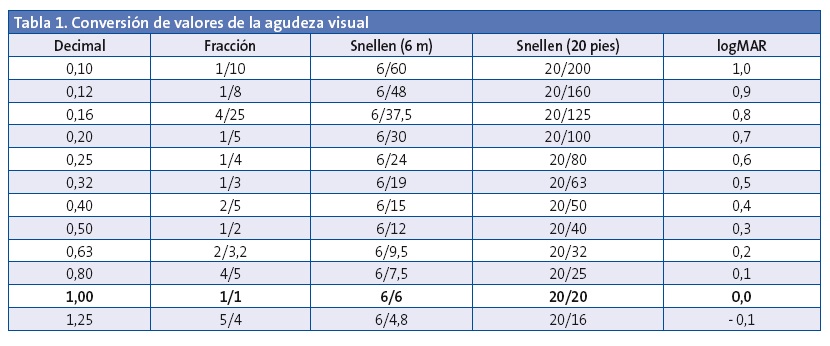
Las características de los optotipos estandarizados son las siguientes:
- Todas las letras o símbolos tienen una legibilidad similar.
- Todas las líneas de optotipos tienen el mismo número de letras o símbolos (idealmente, cinco).
- El espacio horizontal entre las letras o símbolos es igual su anchura y el espacio vertical entre las líneas es igual la altura de las letras o símbolos de la línea inferior.
- Utilizan como escala de medida el logaritmo del ángulo mínimo de resolución (logMAR).
- La diferencia entre cada línea es homogénea. Tiene una progresión geométrica y cada línea supone una variación de 0,1 unidades logarítmicas, lo que representa una diferencia en la agudeza de diez veces respecto a la línea adyacente.
- Los optotipos deben ser negros sobre un fondo blanco, con una luminancia de entre 80 cd/m2 y 160 cd/m2.
Puesto que en todas las líneas hay el mismo número de letras o símbolos y a medida que se desciende van teniendo un tamaño menor, el resultado es una imagen en pirámide invertida. En la Fig. 3 se reproducen diversos optotipos logMAR. Los optotipos no estandarizados, como el de Snellen o las figuras de Allen (Fig. 4), tienen el inconveniente de no tener la misma legibilidad en todas las líneas por no haber el mismo número de símbolos en cada línea ni ser simétrico el espacio entre líneas y entre símbolos. Aunque están ampliamente extendidos, su resultado es menos preciso y no se recomiendan.
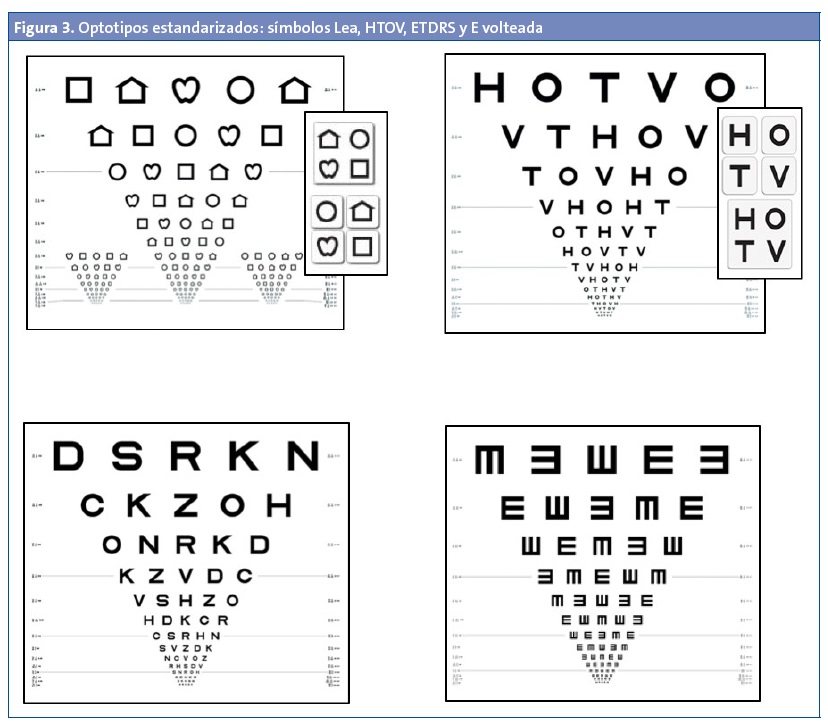
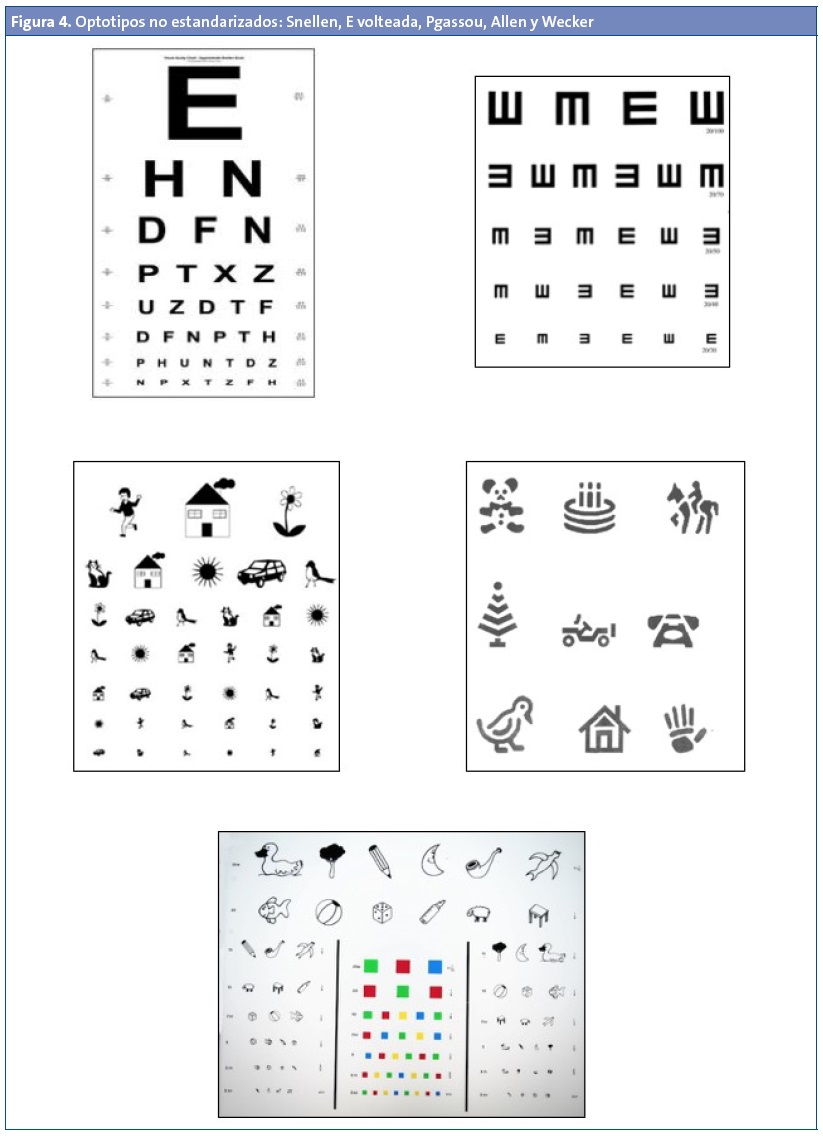
Entre los diversos optotipos basados en el sistema logMAR, los más estudiados para el cribado visual en preescolares (hasta los cinco años) son los de símbolos Lea y los HTOV. Todos los símbolos de los optotipos HTOV y Lea tienen simetría vertical interna (“V” o “H” frente a “B” o “E”, cuya imagen en espejo es distinta), lo que facilita su reconocimiento y puede dar lugar a la obtención de mejores resultados. Los optotipos estandarizados con letras, como los de Sloan o los ETDRS, son adecuados partir de los seis años o cuando el niño pueda identificar las letras. También se pueden utilizar optotipos estandarizados con la E volteada, pero requieren tener habilidades de orientación espacial que tal vez los más pequeños no hayan alcanzado. Los padres pueden preparar a su hijo en el domicilio para la prueba de la E en diferentes posiciones.
PROCEDIMIENTO DE EXPLORACIÓN
La agudeza visual se explora a partir de los tres años con optotipos adaptados a la edad. Entre los tres y los cuatro años es posible conseguir en muchos los casos la colaboración suficiente del niño para realizar la lectura de optotipos, aunque las probabilidades de éxito son mayores a partir del cuarto cumpleaños. En los más pequeños se puede mejorar el rendimiento de la prueba si se permite que el niño señale el objeto en una lámina o lo elija en una tarjeta.
Los carteles de optotipos habituales, con múltiples símbolos o figuras de tamaño decreciente, pueden ser difíciles de interpretar para los niños pequeños. La presentación en una línea completa de figuras con una "barra envolvente" o en figuras individuales rodeadas de cuatro barras individuales (Fig. 5) permite salvar esta dificultad y es la forma más precisa de evaluar la agudeza visual entre los tres y cinco años. Las líneas y las figuras aisladas se rodean de “barras envolventes” porque así son más difíciles de identificar por el ojo ambliope, lo que aumenta la sensibilidad del cribado para detectar la ambliopía. Por la misma razón, es importante no aislar las figuras con la mano para “ayudar” a un niño que muestra dificultades.

El examen se hará en condiciones de buena iluminación, evitando los reflejos, en un ambiente tranquilo y con el niño lo más cómodo posible. Se explora cada ojo por separado, prestando especial cuidado a que la oclusión sea correcta pero no comprima el globo ocular. En menores de seis años se recomienda usar un parche oclusor adhesivo para garantizar que el niño no mira con el ojo ocluido. Si no tolera los parches, existe la posibilidad de usar gafas de oclusión que están disponibles comercialmente5. Si el niño se muestra ansioso, se realiza la prueba con ambos ojos y luego se intenta ocluir cada ojo.
Los optotipos se colocan en el plano horizontal de la visión del niño, a la distancia marcada en la última línea. Idealmente la distancia de presentación de los optotipos para medir la AV en visión lejana es de seis metros (infinito óptico), aunque existen tablas de optotipos diseñadas a diferentes distancias. Entre los tres y los cinco años la distancia preferible es de 1,5 a 3 metros. La distancia óptima es más corta a estas edades porque a una distancia menor es más fácil mantener la atención del niño y evitar distracciones. A partir de los seis años puede utilizarse una distancia de tres a seis metros (en nuestro país es frecuente la distancia de cinco metros). En los optotipos con múltiples figuras de tamaño decreciente, la agudeza visual será la que corresponda a la última línea en la que se puedan leer correctamente más del 50% de las letras o símbolos (por ejemplo, tres de cinco, cuatro de seis)3.
El uso de la “línea crítica” para el cribado es una alternativa razonable y eficiente a la lectura de toda la tabla de optotipos6,7. Con este método, el niño debe identificar correctamente la mayoría de los optotipos de la línea que coincida con la que debe ser capaz de pasar de acuerdo a su edad:
- Tres años: 0,4 logMAR (2/5 Snellen, 0,4 decimal).
- Cuatro años: 0,3 logMAR (1/2 Snellen, 0,5 decimal).
- ³ 5 años: 0,2 logMAR (2/3,2 Snellen, 0,63 decimal), o la línea de 0,66 (2/3) si el optotipo no tiene línea de 0,63.
Una vez comprobado que puede identificar una línea de optotipos grandes con los dos ojos abiertos, iremos directamente a la línea que coincide con su edad para la detección monocular. El niño será derivado cuando no identifique la mayoría de optotipos (más de la mitad, por ejemplo, tres de cinco) en esa línea. No se requieren comprobaciones adicionales con tamaños más pequeños de optotipos.
CRITERIOS DE DERIVACIÓN A OFTALMOLOGÍA
La Academia Americana de Pediatría, la Academia Americana de Oftalmología, la Asociación Americana de Oftalmología y Estrabismo Pediátricos y la Asociación Americana de Optometristas han publicado en enero de 2016 unas recomendaciones oficiales (policy statement) sobre la valoración del sistema visual por los pediatras, en las que se describen los criterios y los métodos de cribado visual8. Estas recomendaciones están complementadas con un informe clínico en el que se detallan los procedimientos de valoración disponibles para el pediatra de Atención Primaria y los criterios de derivación7.
Los niños con riesgo elevado de tener trastornos visuales deben ser remitidos directamente al oftalmólogo9. Los factores de riesgo asociados a una mayor prevalencia de alteraciones visuales son:
- Trastornos del desarrollo neurológico: hipoacusia, alteraciones motoras como la parálisis cerebral, síndrome de Down, deficiencia cognitiva, trastornos del espectro autista y retraso en el desarrollo del lenguaje.
- Enfermedades sistémicas asociadas a alteraciones visuales o uso de medicamentos que pueden causar trastornos oculares.
- Familiares de primer grado con estrabismo o ambliopía.
- Prematuros nacidos antes de las 32 semanas de edad gestacional.
Los criterios de derivación en niños sin factores de riesgo están reflejados en la Tabla 2. Los niños que aparentemente no colaboran tienen mayor frecuencia de alteraciones visuales que los que pasan la prueba de los optotipos. Entre los tres y cinco años, la imposibilidad de valorar la agudeza visual con optotipos después de dos intentos es motivo de derivación al oftalmólogo.
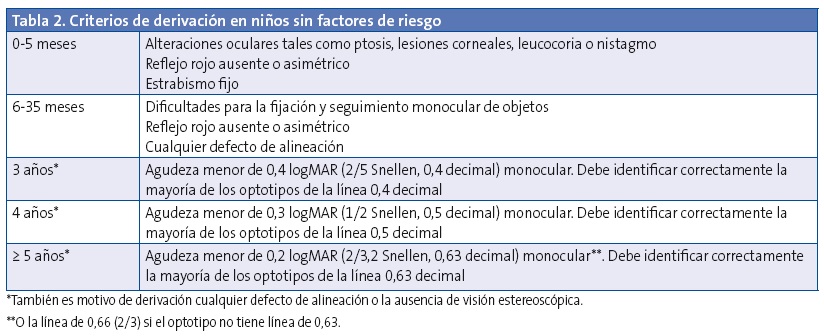
CONFLICTO DE INTERESES
Los autores declaran no presentar conflictos de intereses en relación con la preparación y publicación de este artículo.
ABREVIATURAS: AV: agudeza visual · ETDRS: optotipo basado en el Early Treatment Diabetic Retinopathy Study · HTOV: optotipo basado en las letras h, t, o y v · LogMAR: logaritmo decimal MAR · MAR: minimum angle of resolution.
BIBLIOGRAFÍA
- Bailey IL, Lovie JE. New design principles for visual acuity charts. Am J Optom Physiol Opt. 1976;53:740-5.
- Operational research. Prevention of blindness and visual impairment. En: Organización Mundial de la Salud [en línea] [consultado el 15/07/2016]. Disponible en www.who.int/blindness/partnerships/research/en/
- Visual Acuity Measurement Standard. En: International Council of Ophthalmology [en línea] [consultado el 15/07/2016]. Disponible en www.icoph.org/resources/47/Visual-Acuity-Measurement-Standard.html
- Paediatric Ophthalmology. The Royal College of Ophthalmologists [en línea] [consultado el 15/07/2016]. Disponible en www.rcophth.ac.uk/professional-resources/information-from-the-paediatric-sub-committee-for-healthcare-professionals/
- AAPOS Vision Screening Kit. En: American Association for Pediatric Ophthalmology and Strabismus [en línea] [consultado el 15/07/2016]. Disponible en www.aapos.org/ahp/vision_screening_kit
- AAPOS Techniques for Pediatric Vision Screening En: American Association for Pediatric Ophthalmology and Strabismus [en línea] [consultado el 15/07/2016]. Disponible en www.aapos.org/client_data/files/2014/1075_aapostechniquesforpediatricvisionscreening.pdf
- Donahue S, Baker C, Committee on Practice and Ambulatory Medicine Section on Ophthalmology, American Association of Certified Orthoptists, American Association for Pediatric Ophthalmology and Strabismus, American Academy of Ophthalmology. Procedures for the evaluation of the visual system by pediatricians. Pediatrics. 2016;137:e20153597.
- Committee on Practice and Ambulatory Medicine Section on Ophthalmology, American Association of Certified Orthoptists, American Association for Pediatric Ophthalmology and Strabismus, American Academy of Ophthalmology. Visual system assessment in infants, children, and young adults by pediatricians. Pediatrics. 2016;137:e20153596.
- Cotter SA, Cyert LA, Miller JM, Quinn GE, National Expert Panel to the National Center for Children´s Vision and Eye Health. Vision screening for children 36 to < 72 months: recommended practices. Optom Vis Sci. 2015;92:6-16.
* Una circunferencia tiene 360 grados y cada grado tiene 60 minutos de arco. La longitud de un minuto de arco se calcula dividiendo la longitud de la circunferencia por 360 primero y por 60 a continuación: minuto de arco = 2πr / 360 × 60.




